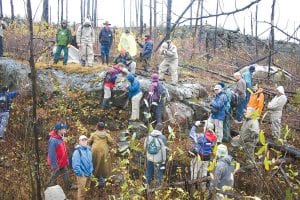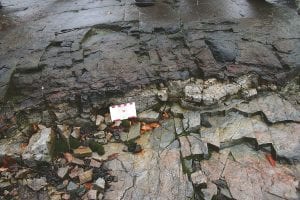A large group of geologists and geology enthusiasts from around the world converged in October on a site that reveals evidence of a catastrophic meteor impact before the days of the dinosaurs. The site was discovered near the end of the Gunflint Trail after the 2007 Ham Lake fire burned the forest down to the rock underneath. (Left) This is a dramatic example of the molten fallout that spread over existing rock like frosting after the mountain-sized meteor hit the Earth several hundred miles away.

What would happen if a mountain about six to ten miles wide fell from space and hit the earth?
What was a bigger event than the meteor impact that is believed to have brought about the obliteration of the dinosaurs?
What might you be doing if you are near someone who says, “The lapilli are fantastic over here!” or “This is a layer cake of stratigraphy!”?
You might be on a field trip in the area of the 2007 Ham Lake fire, where the inferno burned the trees, the underbrush and even the duff down to the bare rock that was created when the world’s second largest meteor strike took place an estimated 1.85 billion years ago, plus or minus a million years.
Several van-loads of geologists and geology enthusiasts from around the world spent a day exploring what is known as the Sudbury impact layer that was discovered near the end of the Gunflint Trail after the Ham Lake fire exposed it. They were on a field trip from the 2011 Geological Society of America conference that drew 6,400 people from around the world to the Twin Cities in October. This trip included a Brazilian, and Austrian, and a German, and some of them were professionals in completely different fields.
No one would be sneaking any meteorites home in his or her backpacks, however. The meteor landed over 600 miles from here, and it was so huge that it vaporized upon impact. All that’s left is the disturbance it made in its wake, the rock that it melted, and the fallout from the crater it left in Sudbury, Ontario, estimated to be as large as 155 miles in diameter.
The meteor’s impact was like an explosion of multiple nuclear bombs, said Mark Jirsa of the Minnesota Geological Survey, leader of the expedition, who discovered this site along with Paul Weiblen of the University of Minnesota Department of Geology and Geophysics.
Within about two to three minutes of impact in what is believed to have been ocean, the Sudbury meteor caused an earthquake, and within one to three hours, a tsunami in the shallow ocean that was right here in northern Minnesota at the time. Metals such as nickel, copper, platinum, and palladium melted, sank, and concentrated. The dust cloud it created took about 10 minutes to get here and covered the entire world for what is believed to have been several years.
The Sudbury impact may have changed the earth so much, including the chemistry of the ocean, that it caused the end of most iron formation on the planet.
The discovery
Fifteen years ago, two scientists from Thunder Bay who knew about the Sudbury meteor started looking for the “ejecta blanket”—the stuff that fell out of the sky after impact. They found it and reported on it in 2005. Ejecta blanket material was subsequently found in Minnesota, Michigan, and Wisconsin.
In 2007, Mark Jirsa was leading a field trip in Cook County during the Ham Lake fire, but half their planned sites were on fire, so he and Weiblen did some exploring where the fire had already gone through. They found some rocks that puzzled them and they showed them to scientists from Thunder Bay in a parking lot in Lutsen where a geology conference was going on. Bingo! They matched the ones that had been found in Thunder Bay.
Six individual points of interest have been identified along a trail that is within sight of Magnetic Rock (at least until the trees grow back). They include outcroppings of shattered and folded rock caused by the violent quaking of the earth, formerly molten debris spreading over existing rock like frosting, and little pebbles embedded in the rock, formed by debris rising and falling in the air through numerous temperatures in a process similar to the creation of hail.
According to Mark Jirsa, our planet was formed by the constant bombardment of meteors. “This has been a classic area to study geology,” he said of Cook County. Three distinct ages of rocks can be clearly seen, from an estimated 2.7 billion years ago, 1.8 billion years ago, and 1.1 billion years ago. What is really special about the Sudbury discovery is the rarity of finding something this old this well preserved. The blanket of debris from the fallout of the Sudbury meteor probably covers the world, but it’s hard to see it in other places.
Mark Jirsa and his colleagues continue to learn more about the impact of the Sudbury meteor. Jirsa published an article about the Gunflint Trail discovery in Astronomy Magazine a couple of years ago but what he has learned since then has changed his thoughts on some of the things he wrote in that article.
“There are still a lot more questions than answers,” Jirsa said.
Another geologist nearby added, “Every time you answer one question, you generate two more.”



Loading Comments